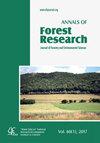使用谷歌地球引擎自动检测杜松树的位置和森林覆盖变化
IF 1.7
3区 农林科学
Q2 FORESTRY
引用次数: 0
摘要
树木检测是评估森林的第一步,尤其是当重点是监测树冠的生长时。国家农业图像计划(NAIP)每年都会获取非常高分辨率的航空图像,并通过谷歌地球引擎(GEE)获取这些图像,这有助于以成本效益和时效性的方式描绘树冠和随时间变化的情况。本研究的目的是开发一种自动方法,从2009年至2016年在美国俄勒冈州收集的多光谱1米分辨率NAIP图像中检测西方杜松(Junipers occidentalis)个体的树冠,并评估森林覆盖的变化。归一化差异植被指数(NDVI)、归一化差异水分指数(NDWI),和比率植被指数(RVI)是根据NAIP图像以及红-绿-蓝近红外波段计算的。为了确定最适合单个树冠识别的方法,我们创建了两个训练数据集:一个单独考虑年度图像,另一个合并所有图像,而不考虑年份。我们使用在GEE中实现的随机森林算法和七个光栅对单个树冠进行分割,即NAIP图像记录的四个光谱带的反射率(即近红外红-绿-蓝)和三个计算指数(即NDVI、NDWI和RVI)。我们将树木的估计位置(计算为树冠的质心)与视觉识别的树梢(视为验证位置)进行了比较。我们发现,单独分析年份时,树的位置误差比合并年份时要小。完整性(74%)、正确性(94%)和平均准确度检测(82%)的测量表明,考虑到只有四个原始输入带用于树冠分割,随机森林算法在树冠描绘方面具有良好的性能。西部杜松的计算树冠面积变化呈正弦曲线,从2011年到2012年有所减少,从2012年到2014年有所增加。所提出的方法有可能使用易于实施的方法,使用定期收集的航空图像,在广泛的空间尺度上估计单个树木的位置和森林覆盖面积的动态。本文章由计算机程序翻译,如有差异,请以英文原文为准。
Automated detection of individual juniper tree location and forest cover changes using Google Earth Engine
Tree detection is the first step in the appraisal of a forest, especially when the focus is monitoring the growth of tree canopy. The acquisition of annual very high-resolution aerial images by the National Agriculture Imagery Program (NAIP) and their accessibility through Google Earth Engine (GEE) supports the delineation of tree canopies and change over time in a cost and time-effective manner. The objectives of this study are to develop an automated method to detect the crowns of individual western Juniper (Juniperus occidentalis) trees and to assess the change of forest cover from multispectral 1-meter resolution NAIP images collected from 2009 to 2016 in Oregon, USA. The Normalized Difference Vegetation Index (NDVI), Normalized Difference Water Index (NDWI), and Ratio Vegetation Index (RVI) were calculated from the NAIP images, in addition to the red-green-blue-near infrared bands. To identify the most suitable approach for individual tree crown identification, we created two training datasets: one considering yearly images separately and one merging all images, irrespective of the year. We segmented individual tree crowns using a random forest algorithm implemented in GEE and seven rasters, namely the reflectance of four spectral bands as recorded by the NAIP images (i.e., the red-green-blue-near infrared) and three calculated indices (i.e., NDVI, NDWI, and RVI). We compared the estimated location of the trees, computed as the centroid of the crown, with the visually identified treetops, which were considered as validation locations. We found that tree location errors were smaller when years were analyzed individually than by merging the years. Measurements of completeness (74%), correctness (94%), and mean accuracy detection (82 %) show promising performance of the random forest algorithm in crown delineation, considering that only four original input bands were used for crown segmentation. The change in the calculated crown area for western juniper follows a sinusoidal curve, with a decrease from 2011 to 2012 and an increase from 2012 to 2014. The proposed approach has the potential to estimate individual tree locations and forest cover area dynamics at broad spatial scales using regularly collected airborne imagery with easy-to-implement methods.
求助全文
通过发布文献求助,成功后即可免费获取论文全文。
去求助
来源期刊

Annals of Forest Research
FORESTRY-
CiteScore
2.20
自引率
11.10%
发文量
11
审稿时长
12 weeks
期刊介绍:
Annals of Forest Research is a semestrial open access journal, which publishes research articles, research notes and critical review papers, exclusively in English, on topics dealing with forestry and environmental sciences. The journal promotes high scientific level articles, by following international editorial conventions and by applying a peer-review selection process.
 求助内容:
求助内容: 应助结果提醒方式:
应助结果提醒方式:


